Multan is one of the ancient towns in Pakistan. Beside its historical importance in the geo politics of Subcontinent, the city has been the hub of great sufis and saints who were the harbingers of Islamic teachings.
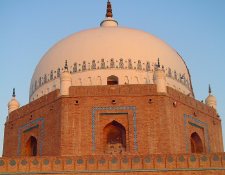
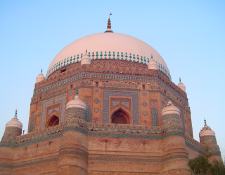
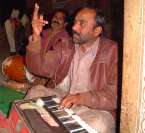
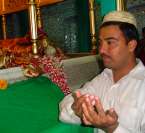
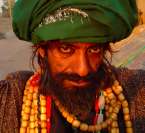
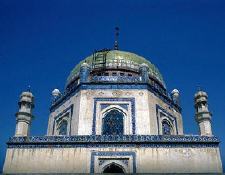
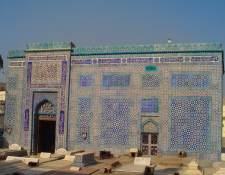
Just as Bahawalpur’s architecture is defined by its political heritage, Multan’s architecture is defined by its religious heritage. Multan is commonly described as the city of saints and shrines. Within the radius of twenty five miles, one finds hundreds of Mausoleums of those saints who propagated Islam in subcontinent with a message of love, peace, fraternity and tolerance and religious harmony.
Sometime back ATP carried a post on the Gateways of Multan. Today, I want to share this pictorial about the Multan’s saints and shrines.
 Sheikh Bahauddin Zakariya commonly known as Bahawal Haq was born in 1170 in Layyah. He went to Iran and received religious education from Sheikh Shahab-ud-Din Suhrawardy in Baghdad. After performing Hajj, and visited Jerusalem, Syria, Baghdad. On his return to subcontinent he settled in Multan in 1222 AD and preached his teachings.
Sheikh Bahauddin Zakariya commonly known as Bahawal Haq was born in 1170 in Layyah. He went to Iran and received religious education from Sheikh Shahab-ud-Din Suhrawardy in Baghdad. After performing Hajj, and visited Jerusalem, Syria, Baghdad. On his return to subcontinent he settled in Multan in 1222 AD and preached his teachings.
His Mausoleum is visited by thousands of people and has great number of followers in Southern Punjab and Sind. Many of his followers when arrive Multan, they put off their shoes as a gesture of respect to this sacred land (Multan Sharif).Shah Rukn-e-Alam was grandson of Bahawal Haq and continued the message of grandfather to the public at large. Thousands of people accepted Islam due to his inspirational teachings. He died at the age of 88 and was buried in the lofty dome built by Ghias-u-Din Tughlaq for himself.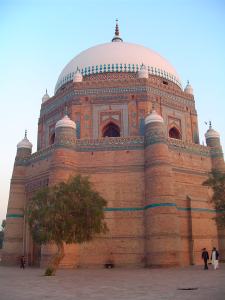
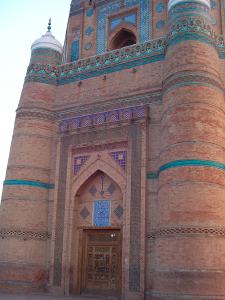
Beside religious importance of the Mausoleum (pictures above), its archeological value cannot be undermined. It is o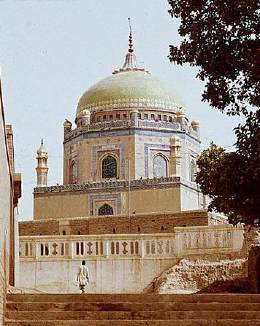 ne of the iconic building in Multan with loft dome that stands 100 feet high from the ground. The use of red bricks with wooden beams is ornamented with blue and white ceramic tiles (Multani tiles) brings a majestic beauty in the building.The descendents of this family have always been influential in government and politics. Makhdoom Shah Mehmood Qureshi is currently the custodian of this Mausoleum.
ne of the iconic building in Multan with loft dome that stands 100 feet high from the ground. The use of red bricks with wooden beams is ornamented with blue and white ceramic tiles (Multani tiles) brings a majestic beauty in the building.The descendents of this family have always been influential in government and politics. Makhdoom Shah Mehmood Qureshi is currently the custodian of this Mausoleum.
Shah Shams Sabzwari, also known as Shah Shams Tebrez, came to Multan in thirteenth century and preached his teaching among the inhabitants of the area. He died in 1276.
Many miracles are associated with his personality. Lot of people comes to this shrine (picture on the left) to pay homage.
Musa Pak Shaheed, was originally from Uch Sharif and descendant of Hazrat Abdul Qadir Jillani. He died in eleventh century and is buried inside the wall city called Pak Gate. The famous Gillani family is the descendant of Hazrat Musa Pak Shaheed.
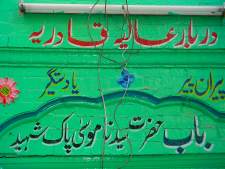
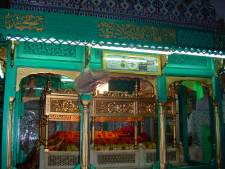

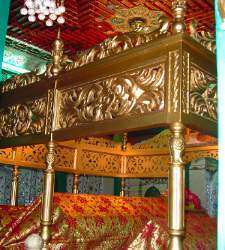
Yousaf Shah Gardezi came to Multan in 1060 and preached his teachings to his disciples. He died in 1088 AD and was buried inside Bohar Gate. He has rectangular Mauseleum with white and blue tiles. His descendant family is still very influential in the area.
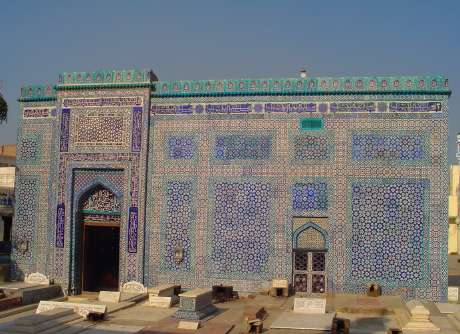
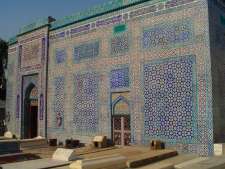
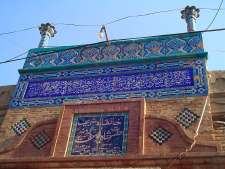
Following are some of the famous shrines in Multan.
- Shrine-Bibi Pak Daman
- Shrine-Hameed-ud-Din Hakim
- Shrine-Qutab-al-qutaab “Moj Dariya”
- Shrine-Syed Pir Sakhi Shah Hassan Parwana
- Shrine-Qazi Qutab-ud-Din Kashani
- Shrine-Syed Hasan Khanjzee
- Shrine-Hazrat Shah Dana Shaheed
- Shrine-Abu Hassan Hafiz Jamal-ud-din “Musa Pak Shaheed”
- Shrine-Hazrat Shah Kamal Qadari
- Shrine-Hafiz Muhammad Jamal Chisti Nazami
- Shrine-Pir Chup Wardi Waly
- Shrine-Mollana Hamid Ali Khan Naqshbandi
- Shrine-Allama Syed Ahmad Saeed Kazmi
- Shrine-Hazrat Khawaja Awais Khagga
- Shrine-Pir Syed Wali Muhammad Shah(Chadar Wali Sarkar)
- Shrine-Hazrat Gul Shah
Roshan Malik is a development practitioner; his earlier posts at ATP include one on the architecture of Bahawalpur. All pictures except those of the shrine of Shah Shams Sabzwari are by the author.



















































Pervaiz Munir Alvi Sb,
These are not only well maintained but still their descendants are into the corridors of power after being elected by the people of the area. And quite interestingly in most cases their opponents are also Pirs like the Faisal Saleh vs Abida Hussain, Shah Mehmood Qureshi vs Javed Hashmi and so on so forth…
Following are some MNAs from South Punjab who are associated with one or the other saint.
Makhdoom Syed Faisal Salah Hayat- Jhang (Shah Jewana)
Sahibzada Muhammad Mehboob Sultan -Jhang (Sultan Bahoo)
Makhdoom Shah Mehmood Hussain Qureshi -Multan (B Zakariya)
Syed Asad Murtaza Gillani- Multan (Moosa Pak)
Mukhdoom Dewan Syed Jaffer Hussain Bukhari- Multan (Jalalpur Pirwala)
Khawaja Sheraz Mahmood- D.G.Khan (Taunsa Sharif)
Makhdoomzadaza Basit Bokhari -Muzaffargarh (Kandh Sharif)
Makhdoomzada Syed Ali Hassan Gillani -Bahawalpur (Uch Sharif)
Syed Tasneem Nawaz Gardezi -Bahawalpur
Makhdoom Syed Ahmad Alam Anwar- Rahim Yar Khan (Kandh Sharif)
Few years ago, Shah Rukn-e-Alam’s mausoleum also received Aga Khan architecture award.
I visited Shah Rukn-e-Alam’s mazaar in summer of 1984. there was a local pir sahib sitting in the center of the mausoleum. He and his disciples were holding some sort of court with lots of people around them. Then the ‘pir’ started distributing one ‘rewRi’ (don’t know English word for this) each to every participant. On my turn I asked for more b/c I liked sweet ‘rewRi’ but was told everyone gets one b/c they’ve been read upon with holy verses. Whatever that means. I think I said aloud ‘andha baaNTay rewRiaaN’ and was ushered out.
We had just gone there to do ‘fateha’ but got into this whole, pir and rewRi episode. That is why I can still remember the whole incident :)
Thanks Roshan for an informative post. Keep them coming.
Very informative. Feel bad again for not knowing my own country as well as I should.
The domes of teh shrines of Bahauddin Zakariya and Shah Rukne Alam are very very similar. Was that on purpose because they are grandfather-grandson?
Mr. Roshan Malik: Thank you for this interesting post. Just like your earlier post on ‘Architecture of Bahawalpur’, this post gives us glimpses of not only the religious but also the architectural aspect of these wonderful historic buildings. May be one day you will give us an exclusive survey of ‘Architecture of Multan’. From your pictures it appears that there are three domed structures here. Two white domed ones belonging to Shaikh Baha-ud-Din and his grandson Shah Rukn-e-Alam respectively and one green domed one belonging to Shah Shams Sabzawari-Tebrez. The forth structure is a beautiful rectangular building without a dome. All buildings appear to be well preserved and maintained. It is ironic that our people are capable of preserving religious-historic structures and not the non-religious-historic structures. It is a reflection on our social values. We are willing to go for an extra mile for religious and spiritual reasons but not for purely historical and architectural reasons. Case in point the relative conditions of the Mausoleums of Emperor Jahangir and others in Lahore and that of Hazrat Gung Buksh for example. Anyhow, thank you again for this lovely treat. Keep them coming please.